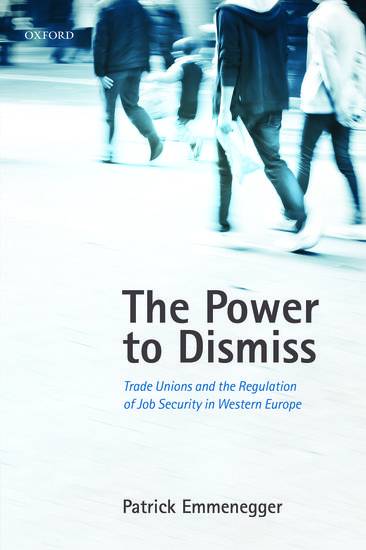Job security regulation is often the focus of passionate debates among scholars, policy-makers and the general public at large. In this book Patrick Emmenegger offers a comparative account of the development of employment protection in eight Western European countries. The thorough analysis of the historical evolution of each national regulation is a relevant contribution offered by this book to students and scholars of comparative labour market studies, writes Elisa Pannini.
 The Power to Dismiss: Trade Unions and the Regulation of Job Security in Western Europe. Patrick Emmenegger. Oxford University Press. 2014.
The Power to Dismiss: Trade Unions and the Regulation of Job Security in Western Europe. Patrick Emmenegger. Oxford University Press. 2014.
Patrick Emmenegger is professor of Comparative Political Economy and Public Policy at the University of St. Gallen (Switzerland). Labour market regulations and job security have been the focus of many of his works; he is among the editors of The Age of Dualization, a collection of papers on the dualization of the labour market of ‘deindustrializing societies’. His latest work, The Power to Dismiss, tackles the issue of regulation of job security and the role of Unions in its origins and developments.
The book offers a vast account of the rise of employment protection legislation in eight Western European countries (France, Italy, Germany, The Netherlands, Switzerland, Sweden, Denmark and Great Britain) and proposes a theoretical framework to explain cross-national variations. Emmenegger points out how, despite a large interest in the analysis of various aspects and effects of job security legislation, there is a lack of research on its historical developments. In chapters 3 to 5, the book provides an overview of the history of the protection of workers from dismissals in the last century. Its narrative follows a chronological order and takes as landmarks the most significant events in European history.
Chapter 3 describes the process of setting up a regulatory regime in each country, from the beginning of the twentieth century to the aftermath of the Second World War. Then, in the following chapter, the author summarises the outcomes of the “Red Wave over Europe”. It is interesting, for example, to read about the origins of seminal pieces of legislation like the Italian Workers’ Statute (1970), ‘the most visible expression of labour movement power’ (p.148) that still has lasting effects on the contemporary debate. The latest period, “The Age of Dualization”, and points out how the latest reforms are leading to an increasing divided labour market in many European countries. For example, the Italian case is particularly telling in this sense, because of the high level of ‘deregulation at the margins’ in recent years, which dramatically decreases employment security for many workers.
This book is relevant to all scholars and students who wish to have at hand an historical overview of job security regulation, from the rise of freedom of contract in the 19th Century to the most recent labour market reforms. Indeed a concise yet complete summary of the facts concerning state regulation, political strategies, and labour movements’ achievements and defeats is essential for understanding contemporary labour market structure and cross national variations. Observing the variety of developments occurred during the last century, also leads to reflect upon the rationality of one-size-fits-all recipes to labour market issues.
The work also explains how and why different regulations arose in the above mentioned countries. Emmenegger critiques the three main explanations offered in the literature so far. First, he questions the Varieties of Capitalism approach; in order to emphasize the alliance between workers, employers and state power, this theory fails to acknowledge the initial opposition of employers to the state regulation of job security. Secondly, he critiques the Social Catholicism thesis arguing that it ‘reads history backwards’ (p.36), because there is no clear causal relationship between the values promoted by Christian Democratic Parties and the reasons at the origins of job security regulations.
The third theory taken into account is the “Power Resources Thesis”. Emmenegger maintains that this is the most relevant explanation of the rise of job security regulation in all of the eight countries examined. The balance of power between the main actors in the industrial relations arena is the focus of the explanation of the levels of protection accorded to labour despite the capital’s efforts to retain control and flexibility of hiring and firing. However, the author questions that this group of theories does not pay enough attention to temporal variations and emphasizes the role of political parties over that of trade unions (p.286).
In the end, the book proposes a new formulation of the Power Resources Thesis. On one hand highlights the role of unions in shaping the regulatory regime of job security, in line with the ‘historical-institutionalist’ approach. On the other hand it also identifies the crucial role of ‘critical junctures’ in defining the milestones along the path of labour market regulation in each country. In a nutshell, Emmenegger stands very close to the Power Resources Thesis, but suggests some adjustments. The key point remains the power struggle between labour and capital, but the account of the development of each regulatory regime focuses on the actions of trade unions at delicate times in history (around World Wars, economic booms or crises). Emmenegger himself admits that ‘to some extent’ his theoretical argument is not ‘new’, but a ‘rediscovery’ of the Power Resources Thesis (p.287).
Indeed, this book does not offer a new compelling explanation of the cross national variation in job security regulation. However, a new theory is not always necessary to make a good book. For students and scholars interested in comparative labour market regulation, this book provides a good source of historical facts related to the development of job security regulation in 8 European Countries, and an interesting literature review on the topic. Beside these main themes, the book offers some sparks on the issue of employment protection that rekindle the interest of the reader, and prompts reflections on a burning issue for scholars, policy makers and the general public.
Note: This review gives the views of the author, and not the position of the LSE Review of Books blog, or of the London School of Economics.








2 Comments